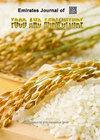沙特阿拉伯吉达市居民食用的绿叶蔬菜中肠道寄生虫的流行率
IF 0.7
4区 农林科学
Q3 AGRONOMY
引用次数: 0
摘要
蔬菜是每种饮食的重要组成部分,也是维生素和矿物质的良好来源。人们会食用许多生蔬菜,如沙拉,而食用被人类和动物粪便污染的生蔬菜会导致各种肠道寄生虫疾病。这项横断面研究的目的是调查绿叶蔬菜受人类肠道寄生虫污染的发生率,并确定吉达各市场和商店出售的供人类食用的绿叶蔬菜中最常见的寄生虫种类以及寄生虫数量的季节性变化。据我们所知,吉达尚未对寄生虫污染蔬菜的流行情况进行过研究。2020 年 9 月至 2021 年 7 月,我们从吉达的各个市场和商店收集了 250 种叶菜(香菜、水芹、莴苣、欧芹、韭菜和葱)。在用蒸馏水完全清洗、检查沉淀物、染色和显微镜检查之后,在实验室对这些蔬菜进行分类、标记和评估。色谱免疫测定也被用来确认寄生虫的身份。在 35.2% 的蔬菜(88/250)中发现了肠道寄生虫。芫荽受到的污染最大(64.2%),而葱受到的污染最小(21.9%)。最常发现的寄生虫是布氏囊虫(55.7%),其次是强直丝虫幼虫(22.7%)和大肠埃希氏囊虫(6.8%)。夏季寄生虫的比例最高,其次是秋季,而冬季最少。蔬菜种类、绿色蔬菜中的季节性寄生虫流行率和寄生虫类型之间没有统计学意义上的显著关系。这些发现突出了检查从寄生虫流行国家种植或进口的蔬菜是否受到寄生虫污染的重要性。在吉达,有几种新鲜绿色蔬菜被肠道寄生虫污染。这表明,经常食用生蔬菜的人可能容易感染寄生虫病。这些发现突出表明,有必要对从寄生虫流行地区种植或进口的蔬菜进行监测。因此,制定策略和控制措施以限制寄生虫引发食源性疾病的可能性至关重要。 关键词:污染;肠道寄生虫;吉达;叶菜本文章由计算机程序翻译,如有差异,请以英文原文为准。
Prevalence of intestinal parasites in leafy green vegetables consumed by inhabitants of Jeddah city, Saudi Arabia
Vegetables are a crucial component of every diet and a good source of vitamins and minerals. Many raw vegetables, such as salads, are consumed, and consuming raw vegetables contaminated with human and animal feces can lead to a variety of intestinal parasite diseases. The goal of this cross-sectional study was to investigate the incidence of contamination of green leafy vegetables with human intestinal parasites, as well as identify the most common parasite species and any seasonal variation in parasite abundance in green leafy vegetables found and sold for human consumption in various markets and stores in Jeddah. To the best of our knowledge, no research has been conducted on the prevalence of parasite-contaminated vegetables in Jeddah. From September 2020 to July 2021, 250 leafy vegetables (coriander, watercress, lettuce, parsley, leek, and green onion) were collected from various markets and stores in Jeddah. The vegetables were sorted, labelled, and evaluated in the laboratory after being completely washed with distilled water, examined for sediment, staining, and microscopically examined. Chromatographic immunoassay tests were also used to confirm parasite identification. Intestinal parasites were discovered in 35.2% of the vegetables (88/250). Coriander was the most contaminated (64.2%), while green onion was the least contaminated (21.9%). Blastocystis spp. was the most often discovered parasite (55.7%), followed by Strongyloides spp. larva (22.7%) and Entamoeba coli cysts (6.8%). Summer has the greatest percentage of parasites, followed by autumn, while winter has the fewest. There was no statistically significant relationship between the kind of vegetable, seasonal parasite prevalence in green vegetables, and parasite type.These findings highlight the importance of inspecting vegetables grown or imported from endemic countries for parasite contamination. In Jeddah, several fresh green vegetables were tainted with intestinal parasites. This demonstrates that those who consume raw vegetables regularly may be susceptible to parasitic illnesses. These findings highlight the need of monitoring vegetables grown or imported from parasitic-endemic areas. As a result, it is critical to establish strategies and control measures to limit the likelihood of parasites in food-borne diseases. Keywords: contamination; intestinal parasites; Jeddah; leafy vegetables
求助全文
通过发布文献求助,成功后即可免费获取论文全文。
去求助
来源期刊

Emirates Journal of Food and Agriculture
AGRONOMYFOOD SCIENCE & TECHNOLOGY&nb-FOOD SCIENCE & TECHNOLOGY
CiteScore
1.80
自引率
0.00%
发文量
18
期刊介绍:
The "Emirates Journal of Food and Agriculture [EJFA]" is a unique, peer-reviewed Journal of Food and Agriculture publishing basic and applied research articles in the field of agricultural and food sciences by the College of Food and Agriculture, United Arab Emirates University, United Arab Emirates.
 求助内容:
求助内容: 应助结果提醒方式:
应助结果提醒方式:


